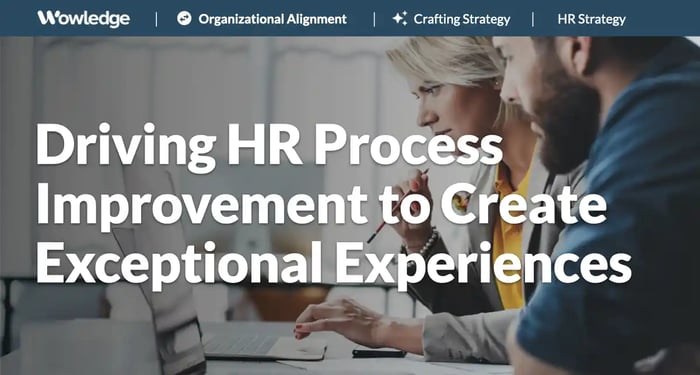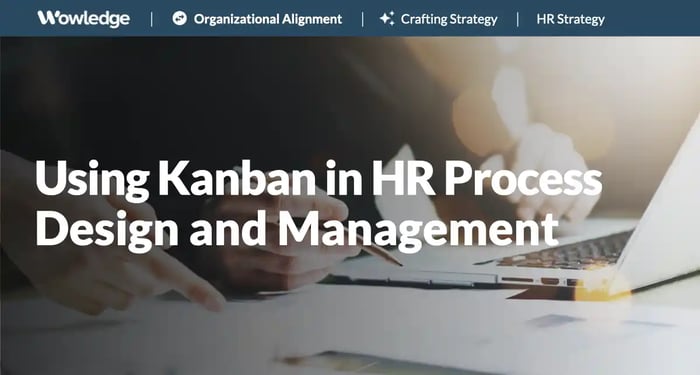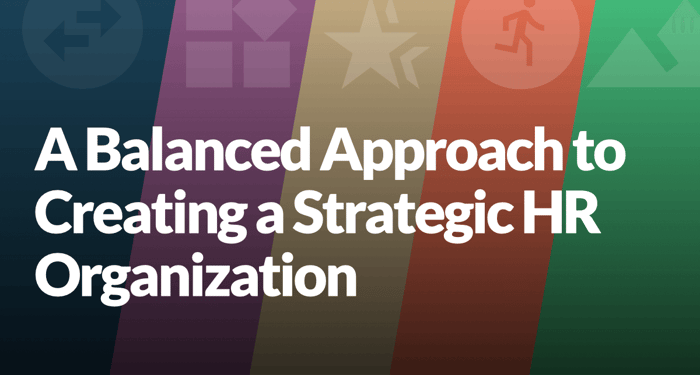Table of Contents
- Leveraging business-based improvement methodologies
- Critical HR processes that require attention
- Common issues with HR processes
- There is potential for real impact from process improvements
- Implementing improvement efforts using proven methodologies
- Choosing the “right” pathway for HR process improvement
- Relevant Practices & Tools
- About Wowledge
Given the near-universal need to make the workplace productive, engaging, and satisfying as organizations respond to numerous pressures to attract, retain, and effectively manage their workforces, the employee experience (EX) reigns as a primary opportunity. A significant element is making the work processes that define much of that daily experience more straightforward to navigate. Considering that much of the frustration about HR comes from those process-based experiences, focusing on HR process improvement can help drive and be promoted as part of the employment brand and employee value proposition (EVP). Facing talent shortages and high levels of turnover, easing the administrative burdens and requirements for managers and employees also allows fewer distractions and increased attention on business-focused efforts related to task completion and goal achievement.
Leveraging business-based improvement methodologies
The notion of improving HR processes has a firm foundation in business process improvement methodologies that have been well-documented and have had significant impacts since William Deming’s work with Japanese manufacturers starting in 1950. He focused their workflow improvement efforts internally between departments and externally with suppliers and customers. This revolutionary work turned post-war Japan into a global economic power. It was introduced and popularized in the early 1980s in the U.S., with similar outcomes for its industries.
The credibility of applying such methods and techniques to HR processes that impact every employee is substantial. Using well-regarded, widely understood, and objectively-based process management techniques can make the function more respected. A focus on HR process improvement also communicates to leadership and line employees a commitment to leveraging and engaging them in designing their preferred experiences, making administrative processes less onerous to navigate and operating as efficiently and cost-effectively as possible.
Critical HR processes that require attention
While much is written and published about continuing to enhance and build strategic HR capabilities and impacts, the most common elements of the HR function are its repeating cycles and processes around attraction, hiring, management, development, and out-processing of employees. With annual turnover rates between 5-20% and employment figures ranging from 50 to 10,000 or more, the number of transactions in any given company throughout the employee lifecycle can be hundreds of thousands. Add to that the increasing calls for more frequent performance check-in meetings, agile workforce and talent planning sessions, training and development activities, and the time spent interacting between employees and those processes becomes a substantial part of their work responsibilities.
The flow of processes can be best outlined through the lens of the employee journey and the talent management practices used to build their careers, including:
- HR planning: Forecasting and managing hiring, administering leaves and absences, assigning shifts and overtime, succession planning and management, assessing skills gaps, and developing mitigation plans.
- Recruitment: Marketing, attracting, processing, assessing, selecting, and hiring candidates, including candidate relationship management, applications, screening, referrals, testing, interviewing, decision-making, and preparing offers.
- Onboarding: Processing, acclimating, and indoctrinating new hires into the company’s systems, databases, processes, and culture.
- Performance management: Clarifying roles and responsibilities, setting goals, coaching and directing, identifying development needs and opportunities, and assessing and documenting performance.
- Compensation and benefits: Setting pay rates, managing merit increases, communicating and enrolling in benefit plans, filing claims, and allocating rewards and recognition.
- Learning and development: Identifying needs, linking gaps and aspirations to content, assessing and building managerial and leadership skills, developing resources and courseware, and managing access and delivery.
- Employee and union relations: Managing complaints and disputes, handling inquiries, responding to legal and regulatory charges, and managing union contracts and relationships.
- Offboarding: Out-processing administration, handling reference checks, managing alumni communications, and relationship management.

Common issues with HR processes
The list of complaints that any HR professional, especially those in the centers of excellence (COEs) and HR Shared Services (HRSS) organizations that typically “own and operate” the processes, is relatively standard. Recruiters hear about burdensome and time-consuming data entry requirements for applicants, benefits administrators field complaints about difficulties navigating and comparing benefit plan options and costs online, managers and employees voice objections to the overly detailed requirements for performance evaluations, and leaders and HRBPs dislike the depth of succession planning assessment and documentation obligations. The primary concerns that serve as a checklist of improvement indicators for process owners can be summarized as follows:
- Too many handoffs and back-and-forth that can stall process cycle times.
- Too much cross-functional oversight and involvement where line managers, HR, and Finance need input, review, and approvals.
- Too many decision-makers or approvers, such as multiple levels of management.
- Too slow cycle times that drive untimely decisions and create frustration.
- Overly complex system interfaces and data entry requirements.
- Data reentry across non-integrated and related systems, such as in new hire paperwork and performance appraisals.
Another operational question that HR leaders should focus on is whether the existing processes either disempower managers or overpower them. For example,
- Does the process or system take judgment out of their hands? Or does it provide guidance and data that help them make quick, quality decisions?
- Does it burden them with unnecessary administrative steps to accomplish the core elements of each task?
- Does the associated system make them look up data about an employee and then enter it into another one?
There is potential for real impact from process improvements
Improving HR processes can drive significant benefits for the organization. Case studies abound that demonstrate how different companies have improved their efficiency, employee productivity, costs of doing business, and effectiveness through targeted process redesign and automation. In fact, McKinsey asserts that 56% of traditional HR processes can be automated to save process cycle time and money.
Going further, KaiNexus suggests that business process improvements drive very attractive results, including 36% of all improvements impacting quality, 31% increasing staff and customer satisfaction, 25% saving time, and 13% saving money (30% of which are annually recurring). Given that the methodologies to identify improvement efforts all engage measurement and data, the opportunity to make identifiable and objective impacts is significant.
Implementing improvement efforts using proven methodologies
Many proven methodologies exist for HR process improvement with available process guides, training, and implementation support. The most popular and well-established include:
- Continuous Process Improvement (CPI) engages employees in reviewing processes and identifying incremental changes in a continuous cycle of identify, change, measure, and repeat.
- TQM focuses on customer satisfaction, employee solution engagement, process discipline, and data reliance for error and bottleneck removal.
- Six Sigma follows a 5 step process (with tools) to identify and remediate process inconsistencies and product or service defects.
- Lean uses Six Sigma tools and methods to focus on process speed and flow. Related approaches include:
- Agile is associated with Lean by focusing teams on quickly adopting workflow improvements through continuous process efficiency and effectiveness data and feedback.
- Kanban is a workflow management practice used to manage, define, and improve product and service delivery in real-time.
- Kaizen uses five steps to assess and make processes more efficient, cost-effective, and quality-oriented through incremental, regular improvements.
- PDCA is a four-step “agile” process (“plan, do, check, and act”) that rapidly designs and pilot-tests process improvements in a small and controlled manner before selecting the best for broader implementation.
- Business Process Management (BPM) is a more generic model focused on improving and automating repetitive tasks to save time and costs and improve productivity.
- SIPOC Analysis (suppliers, inputs, processes, outputs, and customers) is a process mapping-based approach that displays all the inputs, outputs, connections, and decision points in a workflow or process to identify how best to align the process with its participants and end-user needs.
Generally, each of these follow a similar flow:
- Identify the problem process to be evaluated and improved
- Assess the process for inefficiencies, non-value-added steps, cycle time barriers, and substandard outcomes
- Redesign process flows, responsibilities, and automation opportunities
- Measure improvement
- Solidify and track the process for continuing or lasting improvements
They all focus on varying degrees of the process and tend to focus on efficiency, error reduction, eliminating bottlenecks, speeding the cycle time, cutting down on waste, and minimizing redundancies. The most impactful ones include the insights and requirements of end-users and stakeholders. At the same time, some focus on rapid problem identification, resolution ideation, and pilot testing for faster solution definition and creation.

Choosing the “right” pathway for HR process improvement
Finding the most suitable approach is less about the methodology, as most utilize similar (and equally effective) steps to understand the problems, generate potential solutions, implement, and measurably track improvement progress. The primary choices between methodologies are primarily based on the timeframe for the project (rapid prototyping vs. more comprehensive development) and the extent to which to include impacted employees (as data sources or development team members. That said, adopting any model and undertaking of this scale requires awareness and preparation from experts and implementors with field experience. From there, many considerations and lessons emerge.
1. Understand that this calls for a culture shift
Improving HR processes using methodologies developed for engineering, business, and operations purposes and using data analytics can be a challenging “sell” to HR teams. It requires explanation (what it is), context (why we’re doing it and its value), instruction (how to do it), in-process coaching (tools and methods used), support (collecting, computing, and analyzing data), and resources (access to tools and experts.) Guidance needs to be provided regarding the effort's mission relative to broader organizational cultural aspirations, such as asking, “How does this process support or act as a barrier to achieving our culture?” “Does this currently communicate that we trust our managers or employees?” and “How much flexibility do we have to address unique individual or workforce segment needs?
2. Treat this as a continuous process
This is not a one-stop solution. Best-in-class approaches inform this as a practice that can define the growth and adaptation of HR processes that mirror the evolution of a company’s business and culture. Consider the list of HR processes above, and it becomes clear that if one process is reevaluated and upgraded yearly, it will take 12-15 years for most organizations to cycle through them all. Perhaps of equal value, it is an excellent development vehicle for HR and line managers or employees who can benefit from cross-functional learning and exposure, evidence-based and data-driven decision experience, team or sub-team leadership opportunities, and cross-organizational network building.
3. Create a focus on the end-user
Regularly evaluating and improving HR processes creates a sustainable and highly desirable focus on the end-user as a “customer,” supporting the value of employee experience (EX) and candidate experience (CX), which generate their own superior outcomes. These methodologies rely on data generated in part from existing employee listening strategies such as engagement surveys, post-process- and system-use pulse surveys, focus groups, and executive skip-level employee sessions. This can also be augmented by human-centered design and design thinking approaches to identifying issues, understanding of typical users and their expectations, skills, and needs from a process, and solution design inputs.
4. Use data to prioritize process improvements and understand weaknesses
Understanding the areas in which HR process improvement can be started can hamstring many, which leads to insight into using data to determine prioritization targets. The key to prioritizing processes for enhancement can depend on several factors, starting with the “pain points” that people are experiencing and reporting and then assessing which ones have the highest relative impact on business operations and goals. The opportunity to generate advanced (e.g., regression) analyses of process performance's impact on business outcomes is substantial but often represents too big a reach for many HR teams.
Instead, use employee experience methods that generate “journey maps” and identify “moments that matter” (MTMs) to understand which processes are in line for optimization. Then, leverage employee surveys, complaints, and system trouble ticket logs to prioritize processes. Pay close attention to feedback from the employee segments that are most critical to operations and use their input to rank order potential processes to study and upgrade. Further, the IT team’s reports on HR system usage patterns can be used to identify those with low usage, high (mid-process) abandonments, and error or rework rates to list trouble areas objectively.
5. Create process maps to inform design and enhancements
Process mapping is an elegant and highly effective way to visualize and simplify workflows when improving HR processes. Particularly when they have vertical “swim lanes” that identify the participants in each step, they enable the quickest way to discover and evaluate process hand-offs, approvals, systems inputs and outputs, levels of approval, data entry points, and decisions. These can reveal unnecessary administrative steps, opportunities for system-fed policy decisions, integration opportunities, and opportunities to minimize human-intervening approvals. Further use of RACI (“Responsible, Accountable, Consulted, and Informed”) charts can clarify the value-add (or not) of each participant’s action and responsibility within the process.
6. Engage workers and process experts in solving their own issues
The power of employee involvement in HR process improvement cannot be understated. Having end-users provide insights into points of pain or failure, unwieldy steps, and system interfaces sends a message about how much the organization values their insights, expertise, and inputs. Another form of design thinking, engaging end-users ("employee involvement"), builds trust and confidence in its use and can help with change management efforts related to adoption and acceptance rates.
7. Fix the process first, then automate or re-automate
In all cases, automating a poorly designed and ineffective process creates a new source of frustration that can only impede the reason automation was installed—to improve process efficiency and effectiveness. This means a process should be updated and optimized before a new technology is selected. With that, system requirements can be generated against a solid process, and vendors can be down-selected based on their ability to provide features and functions that directly enable and support that design. An added consideration is the need for one-size-fits-all vs. tailored process solutions and interfaces that should be documented before systems are considered. Examples might include different performance management processes, criteria, and forms for salespeople or executives separate from those for all other employees.
8. Integrate systems with overlapping data needs
The topic of automated systems looms large in improving HR processes, as they are extremely common and can exert substantial influence on process design. While redesigning processes, address a common complaint upfront by identifying overlapping data used across HR processes and have them available for auto-population into required forms and supporting material in the target system or module. Social security numbers for payroll and employee benefits are a good example, as is data related to job title and grade, which is used across recruiting, performance, succession, and other systems or modules.
9. Consider the use of AI technologies
As HR systems are updated with ever-increasing advances, the influence of AI and machine learning capabilities on HR process improvement can be substantial. Robotic Process Automation (RPA), for example, allows the automation of repeatable tasks, such as using “chatbots” or cognitive agents to guide candidates through a more efficient application process or handle employee inquiries. Other applications include “bots,” which can automatically transfer ATS data into the HRIS, draft offer letters, and set up new employee profiles in the payroll system.
10. Plan on measurement as a standard element
Measurement is crucial to improving HR processes within the assessment, design, improvement, continuous monitoring, and reporting steps. Measures of efficiency (time, volume, cost), effectiveness (frequency of use, ratings of utility, satisfaction), and outcomes (impact on productivity, performance, skill growth, talent availability) are equally valuable as KPIs for monitoring purposes.
11. Manage change in a disciplined manner
Any improvement effort represents a change, as does the updated process design. HR process improvement efforts typically affect many, if not all, employees and, as a result, require a structured and thorough approach to communicating the effort, its business rationale and changes, training managers and employees on its proper use, and engaging leaders and employee influencers to drive acceptance and adoption. Changes without a comprehensive strategy that supports the effort can lead to uneven application and use varying levels of support, and an under-optimized return on investment.
Relevant Practices & Tools
Core Change Management Practices to Engage Stakeholders and Drive Sustained Adoption. >
Simply put, Change Management – sometimes called Organizational Change Management, Behavioral Change Management, or Change Enablement – is a set of activities to help... more »
Using Technology to Deliver Streamlined HR Services and Insights. >
HR Technology has advanced to a level where it is currently capable of offering scalable productivity gains in processing HR transactions, with emerging technologies capable... more »
Driving Adoption of the Digital Future to Optimize the Return on Digital Investments. >
The digital transformation will deliver a new way of operating for the business. It establishes a new status quo for what employees expect, how they work individually or in teams... more »
Establishing a Core Talent Management Strategy to Set Priorities and a Strategic Roadmap. >
As a company defines its business strategy, each function must align its objectives and actions to support its strategic goals. Talent management strategy is a key process that the HR function... more »
The Stakeholder Engagement Plan Template: Identify Needs and Activities to Support Stakeholders During Digital Transformation. >
Analyzing stakeholder interests and the impact of digital transformation efforts on them is critical to proper engagement planning... more »
About Wowledge
Wowledge is the expert-driven platform for lean teams building strategic HR programs. Members enjoy access to up-to-date best practices, step-by-step guides, tools, templates, and insights to accelerate the design and implementation of all key HR programs and processes.
Since each organization has unique characteristics, needs, and aspirations, Wowledge's practices are developed utilizing an exclusive stage-based approach – from Core to Advanced to Emerging – that reflects distinct levels of sophistication to meet our members where they are.
Build strategic HR programs with refreshingly easy-to-follow best practices.
Get started for FREE! Learn more.










